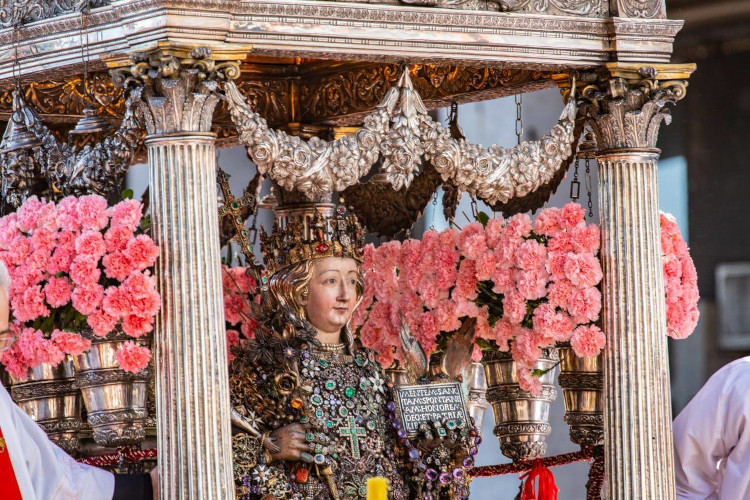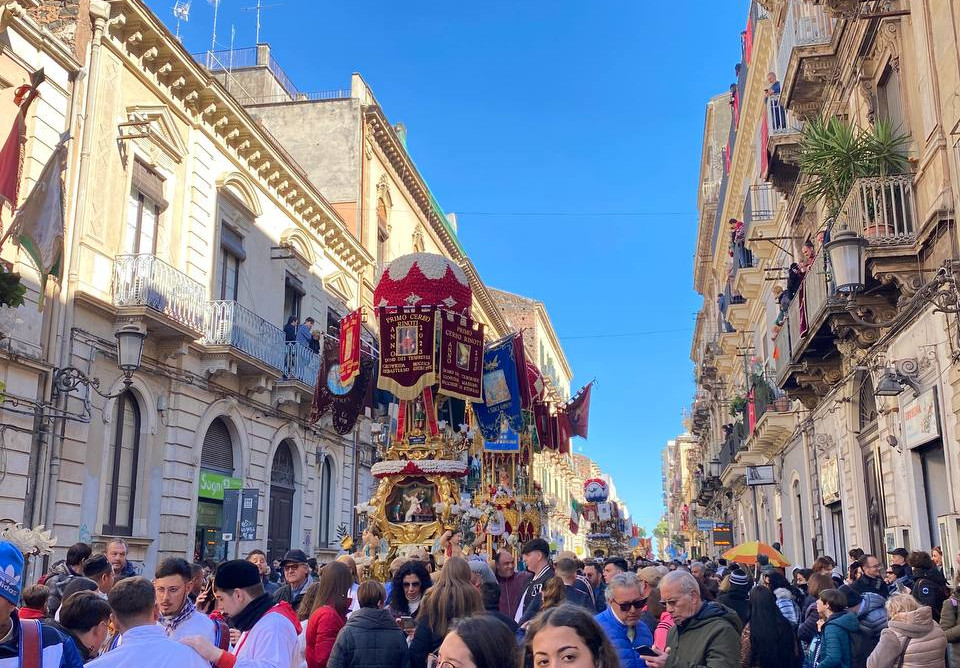Last weekend, from 3 to 5 February 2023, all of Catania was in a state of emergency: for three days, one of the biggest religious festivals in the world was celebrated. Millions of people flooded the streets in intense adoration of their city patron, Saint Agatha.
The figure of St. Agatha is venerated in various forms throughout the year, but on these days a religious enthusiasm is concentrated by all age groups that no longer exists in many other European countries. As in other aspects, Sicily gives one the unique and precious opportunity to immerse oneself a little in a largely long-buried time.
The course of the celebrations
Weeks before the festival, the preparations begin. The city is exuberantly decorated with flowers, lights and pictures, food stalls are set up, routines are rehearsed. During the festive processions, gigantic statues – so-called “Candelore” or “Cerei di Sant’Agata” – are carried through the city by a whole group of men – a coordinated feat that has to be trained.

Each of these 14 statues is a kind of altar dedicated to a certain field or occupational group, for example baking or fruit and vegetable growing. They are artistically made of wood, covered all over with flowers and so heavy that the 8 or so men carrying them have to stop again and again to rest. The “Candelora degli Ortofrutticoli” (fruit and vegetable statue), affectionately called “La Signorina” by Sicilians, weighs 650 kg and is carried from one end of the city to the other. The “candelore” are the centrepiece of the procession, they rise impressively and brightly from the crowd, originate from an ancient tradition and are charged with religious, social and cultural significance.
On the first day, mass begins at sunrise in the packed Saint Agatha Cathedral, after which the richly decorated statue of the saint is carried out to meet the cheering crowd. The Agatha worshippers wear white robes, wave white cloths through the air, carry huge candles weighing up to 40kg, ask for a miracle or give thanks for one they have experienced, sing in ecstatic states and fireworks light up the sky.
Delicacies for the celebration
Food is offered on every corner during the festival. Typically, in addition to the well-known Sicilian arancini, you will also find “Calia e Simenza”, another Sicilian speciality made from roasted and salted chickpeas and pumpkin seeds, “Torrone”, a hard sweet pastry made from almonds in sugar, or a special pasta with chickpeas.
Some of the traditional dishes are directly inspired by the legend, such as a dessert called “Cassatella di Sant’Agata“, whose shape is supposed to recall the cut breasts and thus Agata’s sacrificial pain: small, hill-shaped cakes made of a fluffy dough filled with ricotta, covered with marzipan and a red, candied cherry on top.

Another speciality of these days are the green “olives” made of marzipan, which symbolically remind us of another episode in the legend: supposedly, at the place where Agatha tied her shoe while fleeing from the soldiers, an olive tree grew, which not only offered her a hiding place, but also shade and precisely olives to refresh and strengthen her.
Life and Death of Saint Agatha
The legend of St. Agatha of Catania is extraordinarily gruesome, but tells of the remarkable mental strength of a young, self-confident woman and the vengeful jealousy or wounded pride of a rejected suitor.
Agatha was born around the year 230 into a wealthy family in Catania. She was well educated, which was unusual for a young woman at that time, and was brought up as a Christian by her family. At a very early age, she decided to devote herself entirely to the faith and consecrate her virginity to heaven.
According to legend, the pagan governor of Catania, Quintianius, fell in love with Agatha at first sight, wanted to make her his wife and demanded that she renounce her faith. Agatha remained faithful to her vow and rejected him. The powerful man could not bear this perceived humiliation and tried to change her mind or punish her by the cruellest methods of torture, including cutting off her breasts.
Agatha could not be dissuaded, spent the nights in captivity in prayer and, according to legend, Saint Peter appeared to her and healed her wounds. However, the vengeful man did not let up and finally Agatha died as a result of the torture.
Saint Agatha and Mount Etna
Almost exactly one year to the day after her death, on 1 February 352, the volcano Etna erupted and formed the crater Monpeloso north of Nicolosi. The lava flowed towards Catania and people are said to have placed Agatha’s veil in front of the lava flow. This stopped in front of Catania, the city was saved and the miracle was attributed – as the first in a series – to the saint
There is a second festival, on 17 August, dedicated to Saint Agatha and honouring the day her lost body was brought back to Catania, but the festival at the beginning of February is the big highlight of the year.
Saint Agatha is also patron saint of the dwarf republic of San Marino, one of the richest countries in the world, and of the island of Malta in southern Sicily.
